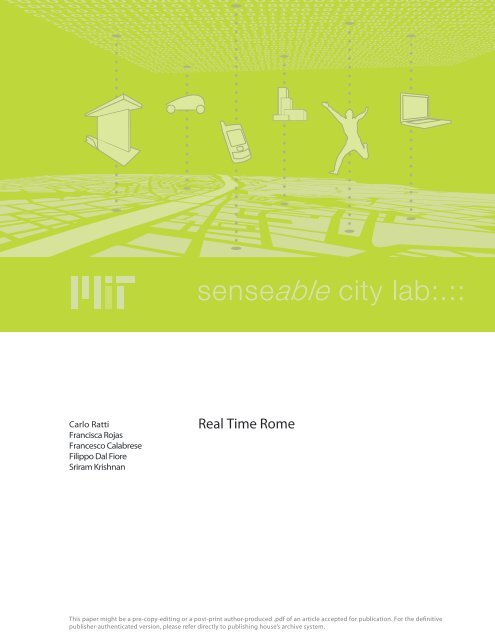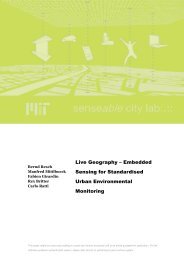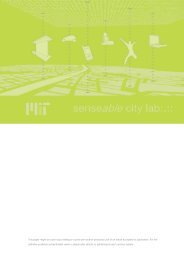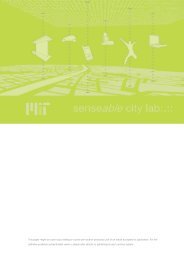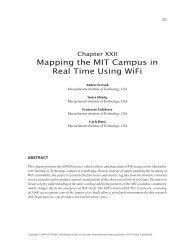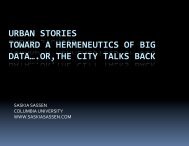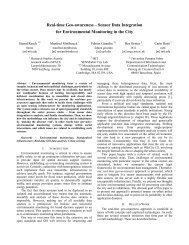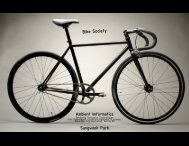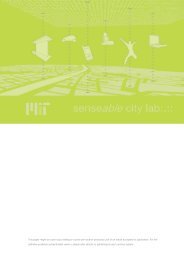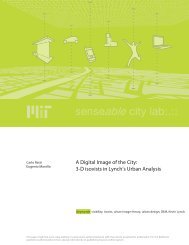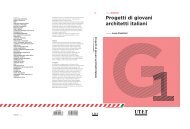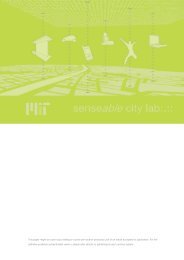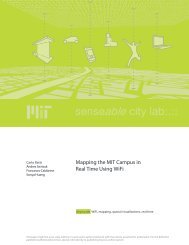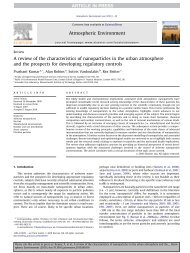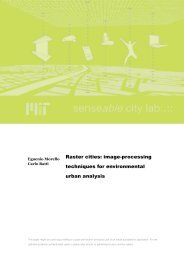Real Time Rome - MIT SENSEable City Lab
Real Time Rome - MIT SENSEable City Lab
Real Time Rome - MIT SENSEable City Lab
Create successful ePaper yourself
Turn your PDF publications into a flip-book with our unique Google optimized e-Paper software.
Carlo Ratti<br />
Francisca Rojas<br />
Francesco Calabrese<br />
Filippo Dal Fiore<br />
Sriram Krishnan<br />
<strong>Real</strong> <strong>Time</strong> <strong>Rome</strong><br />
This paper might be a pre-copy-editing or a post-print author-produced .pdf of an article accepted for publication. For the de�nitive<br />
publisher-authenticated version, please refer directly to publishing house’s archive system.
<strong>Real</strong> <strong>Time</strong> <strong>Rome</strong><br />
Francisca Rojas, Francesco Calabrese, Filippo Dal Fiore,<br />
Sriram Krishnan, Carlo Ratti<br />
<strong>MIT</strong> <strong>SENSEable</strong> <strong>City</strong> <strong>Lab</strong>oratory<br />
10-400, <strong>MIT</strong><br />
77 Massachusetts Avenue, Cambridge, MA 02139, USA<br />
phone: + 1 617 253 7926<br />
e-mail: ratti@mit.edu<br />
Abstract<br />
The real-time city is now real! The increasing deployment of sensors and hand-held electronics (such as mobile<br />
phones) allows a new approach to the study of cities and the built environment. In the visualizations of <strong>Real</strong> <strong>Time</strong><br />
<strong>Rome</strong> we synthesize data from various real-time communications and transportation networks to understand<br />
patterns of daily life in <strong>Rome</strong>. We interpolate the aggregate mobility of people according to their mobile phone<br />
usage and visualize it synchronously with the flow of public transit, pedestrians, and vehicular traffic. This reveals<br />
for the first time the relationships between fixed and fluid urban elements: how people use neighbourhoods during<br />
the course of the day, how the distribution of buses and taxis correlates with densities of people and how different<br />
social groups, such as tourists and residents, inhabit the city - in short, how the formal structure of the city relates<br />
with the informal, bottom-up patterns of daily life.<br />
Introduction<br />
“…And then came the grandest idea of all! We actually made a map of the country, on the scale of a mile to the<br />
mile!”<br />
“Have you used it much?” I enquired.<br />
“It has never been spread out, yet,” said Mein Herr: “the farmers objected: they said it would cover the whole<br />
country, and shut out the sunlight! So we now use the country itself, as its own map, and I assure you it does<br />
nearly as well…”<br />
Lewis Carroll, The Complete Sylvie and Bruno, 1893<br />
<strong>Real</strong> <strong>Time</strong> <strong>Rome</strong> is the <strong>MIT</strong> <strong>SENSEable</strong> <strong>City</strong> <strong>Lab</strong>’s contribution to the 10 th International Architecture<br />
Exhibition in Venice, Italy, dedicated to Cities, Architecture and Society held in 2006. The project<br />
used data from mobile phones, buses and taxis to better understand urban dynamics in real time. By<br />
revealing the pulse of <strong>Rome</strong>, the project shows how visualizations of data generated by everyday<br />
digital devices can help us observe the ways people and urban systems use urban space. In the long<br />
run, individuals will be able to use tools such as these to make more informed decisions about how<br />
they move about their environment and thus reduce the inefficiencies of present day urban systems and<br />
open the way to a more sustainable urban future.<br />
Project Statement<br />
In today’s world, wireless mobile communication devices are creating new dimensions of<br />
interconnectedness between people, places, and urban infrastructure. This ubiquitous connectivity<br />
within the urban population can be observed and interpreted in real time through aggregate records<br />
collected from communication networks.<br />
The visualizations of <strong>Real</strong> <strong>Time</strong> <strong>Rome</strong> expose the dynamics of the contemporary city as urban systems<br />
coalesce: traces of information and communication networks, movement patterns of people and<br />
transportation systems, spatial and social usage of streets and neighbourhoods. Observing the real-time<br />
123
city becomes a means to understanding the present and anticipating the evolution of urban<br />
environments.<br />
In the visualizations of <strong>Real</strong> <strong>Time</strong> <strong>Rome</strong> we synthesize data from various real-time networks. We<br />
interpolate the aggregate mobility of people according to their mobile phone usage and visualize it<br />
synchronously with the flow of public transit, pedestrians, and vehicular traffic. By overlaying<br />
mobility information onto geographic references of <strong>Rome</strong> we reveal the relationships between fixed<br />
and fluid urban elements. These real-time maps help us understand how neighbourhoods are used in<br />
the course of a day, how the distribution of buses and taxis correlates with densities of people and how<br />
different social groups, such as tourists and residents, inhabit the city. Using the resulting<br />
visualizations, users can react to the shifting urban environment.<br />
<strong>Rome</strong>’s mapping legacy<br />
<strong>Real</strong> <strong>Time</strong> <strong>Rome</strong> fits into a long legacy of depicting the city of <strong>Rome</strong> through maps. Historical<br />
depictions of <strong>Rome</strong> are superb examples of how maps abstract a single perspective and reveal the<br />
dominant ideas about the city at a particular time.<br />
Giambattista Nolli’s representation of the city in 1748 is the first iconographic map of <strong>Rome</strong><br />
(previously, the city had been drawn from a bird’s eye view). In detailing the city’s streets and the<br />
interiors of public buildings as public space, this map illustrates how social and public life was valued<br />
in late-Renaissance <strong>Rome</strong>. From another perspective and another time, Edmund Bacon’s (1974)<br />
diagrammatic plans of Sixtus V’s urban interventions reveal the logic and significance of landmarks<br />
for our understanding of the Eternal <strong>City</strong>.<br />
Today’s electronically interactive maps by Google Earth (2006) combine detailed aerial and satellite<br />
images, sophisticated zooming-panning abilities and local search functions. These maps are also<br />
modifiable by users when combined with geotagged, place-related information. <strong>Real</strong> <strong>Time</strong> <strong>Rome</strong> takes<br />
those capabilities further to dynamically reveal the rhythm of the city as it occurs, in real time.<br />
System architecture<br />
For the <strong>Real</strong> <strong>Time</strong> <strong>Rome</strong> project, the <strong>MIT</strong> <strong>SENSEable</strong> <strong>City</strong> <strong>Lab</strong> obtained mobile phone, bus and taxi<br />
data directly from <strong>Rome</strong> and transformed it into the visualizations displayed at the exhibition hall in<br />
Venice by the following means.<br />
From the city of <strong>Rome</strong>, we collected time-stamped location data simultaneously from the mobile<br />
phone subscribers of Telecom Italia, public buses run by the local public transport authority Atac and<br />
taxis run by the Samarcanda company. The Telecom Italia network base stations used an innovative<br />
location platform called 'Lochness' to collect and process data about mobile phone users throughout the<br />
city of <strong>Rome</strong> in an anonymous and aggregate format using two methods:<br />
1. by measuring Erlang, which describes the amount of telecommunications traffic in a particular<br />
area (one Erlang is one person-hour, or the equivalent of one caller speaking for one hour on one<br />
phone or two callers speaking for 30 minutes each);<br />
2. by recording and processing with ad-hoc algorithms the signal strength of mobile phones engaged<br />
in calls in a particular area of <strong>Rome</strong> (for this purpose, the city of <strong>Rome</strong> was divided into a grid of<br />
250 meter by 250 meter squares).<br />
The Atac buses and the Samarcanda taxis carried Global Positioning System (GPS) devices, which<br />
calculated each vehicle’s location based on GPS satellite transmissions and reported this data to the<br />
Atac and Samarcanda servers in real time.<br />
A secure server set up at the <strong>MIT</strong> <strong>SENSEable</strong> <strong>City</strong> <strong>Lab</strong> in Cambridge, Massachusetts, continuously<br />
collected the real-time aggregate mobile phone and GPS data from Telecom Italia, Atac and<br />
Samarcanda, and ran custom-designed software to analyze it together with geographic references of<br />
<strong>Rome</strong> – like the satellite maps provided by Google. Computers in the Venice Biennale exhibition, one<br />
for each screen, constantly acquired the processed data from the <strong>SENSEable</strong> <strong>City</strong> <strong>Lab</strong>’s server at <strong>MIT</strong><br />
124
and ran algorithms to visualize the different dynamic maps of the city in real-time. The outcome of this<br />
process is shown in figures 2-7.<br />
The <strong>Real</strong> <strong>Time</strong> <strong>Rome</strong> project respects individual privacy and only used aggregate data already<br />
collected by communication service providers. At no time could individual users be identified based on<br />
the data that was collected and analyzed.<br />
The schematic of the data collection and transfer is presented in Fig. 1.<br />
Screens<br />
<strong>Real</strong> <strong>Time</strong> <strong>Rome</strong> used six different screens or visualizations to present real-time information about the<br />
dynamics in <strong>Rome</strong>. Snapshots of each of these screens are presented in Figures 2-7. Each screen<br />
addresses a question about <strong>Rome</strong>, which in many cases could not have been explored prior to the<br />
availability of real-time data produced by the widespread use of digital communication technologies.<br />
Pulse – What are the patterns of use in <strong>Rome</strong>?<br />
Where in <strong>Rome</strong> do people converge over the course of a day? This software visualizes the intensity of<br />
mobile phone calls in <strong>Rome</strong> at a given moment and compares it to yesterday’s data. Unsurprisingly,<br />
this visualization shows how over the course of a day, the intensity of activity moves from the<br />
periphery of the city in the early morning towards the central parts of the city as the work day begins.<br />
In the late afternoon, that pattern is reversed as people leave work and return to their neighbourhoods.<br />
Connectivity – Is public transportation where the people are?<br />
How do the movement patterns of buses and taxes and pedestrians overlap in the neighbourhoods<br />
around the central station (Stazione Centrale)? This software shows the changing positions of Atac<br />
buses and Samarcanda taxis indicated by yellow points, and the relative densities of mobile phone<br />
users, represented by the red areas. If a tail on a yellow point is long, this means that a bus or a taxi is<br />
moving fast. Areas coloured a deeper red have a higher density of pedestrians.<br />
Flow – Where is traffic moving?<br />
This software visualizes the movement of mobile phone callers travelling in vehicles. It focuses on the<br />
area around the Stazione Termini and the Grande Raccordo Anulare (<strong>Rome</strong>’s ring road). Red indicates<br />
areas where traffic is moving slowly, green shows areas where vehicles are moving quickly, and<br />
arrows represent the dominant direction of travel.<br />
Icons – Which landmarks in <strong>Rome</strong> attract more people?<br />
This software shows the density of people using mobile phones at different landmarks and attractions<br />
in <strong>Rome</strong> such as the Colosseum, and Trevi Fountain. The location in green is the most popular, while<br />
the location in red is the least popular. At the bottom of the screen is a week-long data comparison<br />
between the most popular site and the least popular site.<br />
Visitors – Where do tourists congregate?<br />
Where are the concentrations of foreigners in <strong>Rome</strong>? This 3-D software highlights a 24-hour loop of<br />
the locations around the Stazione Termini neighbourhood of <strong>Rome</strong> where tourists are speaking on<br />
mobile phones. The software uses SIM card data from the mobile phones in the area to distinguish<br />
Italians from foreign visitors.<br />
Gathering – What does <strong>Rome</strong> look like during special events?<br />
How do people occupy and move through certain areas of the city during special events? This software<br />
shows the pre-recorded movements of mobile phone users during two notable events in <strong>Rome</strong> during<br />
the summer of 2006:<br />
125
• Viewing the World Cup final match between Italy and France on July 9, 2006, and<br />
celebrating the arrival in <strong>Rome</strong> of the winning Italian national team on July 10.<br />
• Madonna’s concert in <strong>Rome</strong> on August 6, 2006.<br />
The software recorded great spikes of mobile phone use during particularly emotional moments during<br />
both events. Figure 7 shows people making calls during Madonna’s controversial performance in front<br />
of a mirrored cross.<br />
Analysis<br />
One of the main contributions of the <strong>Real</strong> <strong>Time</strong> <strong>Rome</strong> project is the development of a visualization<br />
tool with the potential to empower individuals and city officials to make decisions using dynamic,<br />
location-specific information. Mobile phone data acquired in real time can eventually enable a chain of<br />
bottom-up decisions, which can then result in a better use of urban resources.<br />
For example, the screen titled Connectivity (Figure 3) indicates how the locations of public<br />
transportation and pedestrians evolve simultaneously. For a transit authority, such information could<br />
influence the design of more responsive and accurate transit routes to serve riders. For pedestrians,<br />
such information could provide a better set of options with which to optimize their mode of<br />
transportation and minimize time in transit.<br />
The Icons screen (Figure 5) reflects the metamorphosis of spontaneous social gatherings. By showing<br />
the concentration of visitors at important landmarks in <strong>Rome</strong>, we see which destinations are more<br />
popular during different times of day or different days of the week. Will standard queuing theory apply<br />
so that tourists try to visit less crowded locations? Or, will people attract more people, as Whyte (1988)<br />
proposed, with tourists being drawn to the desirability of a venue, thereby increasing the flow of<br />
visitors to already crowded locations? If such visualizations were available to residents and visitors in<br />
<strong>Rome</strong>, they could individually decide whether to join or avoid the crowds.<br />
Thus, a database of real-time information can be useful to different audiences at different levels of<br />
urban activity – from those city officials charged with logistics like traffic flow or service delivery to<br />
individual inhabitants who want to maximize their utility in urban space (by avoiding traffic or by<br />
participating in public gatherings). The possibilities of real-time, aggregated, and location-specific<br />
information in a city are endless. With <strong>Real</strong> <strong>Time</strong> <strong>Rome</strong>, we hope to both uncover some of these<br />
possibilities and set the stage for further work on the use and importance of such information to a city<br />
and its population.<br />
Returning real-time information to final users<br />
The <strong>Real</strong> <strong>Time</strong> <strong>Rome</strong> software and visualizations present a novel methodology and tool made possible<br />
through the dynamic data that is already being collected by communications and transportation<br />
providers. This approach presents both professionals concerned with urban issues and informal<br />
networks of urban inhabitants with perspectives on the city that are now made possible due to the<br />
proliferation of mobile digital devices. At an academic level, the quality and quantity of data collected<br />
through the system provides an unprecedented dataset for testing urban theories of space and mobility.<br />
At the level of the urban inhabitant, the availability of this data can spur the development and<br />
prototyping of innovative ICT applications for individual users, which can provide people with useful<br />
feedback information on the real-time conditions of the city. As Townsend (2006) explains, the<br />
availability of context-aware data and computing will allow, “…an interplay between top-down<br />
systems for command and control and bottom-up systems for collective action”.<br />
From a bottom-up, user’s perspective, several questions must be addressed in order to ensure that realtime<br />
information feedback services are meaningful and useful to final users:<br />
• Who are the final users? And how does that influence how the data is visualized?<br />
126
<strong>Real</strong> time information such as that which is made available through the <strong>Real</strong> <strong>Time</strong> <strong>Rome</strong><br />
project can be useful in different ways to many types of city stakeholders, such as residents,<br />
city officials, commercial entities, and research institutes.<br />
• How is real-time information useful to final users?<br />
<strong>Real</strong> time, location-based information can be useful for instant decision-making and<br />
behavioural change (i.e. changing driving directions after knowing real-time traffic<br />
conditions) or for better future decision-making on the basis of aggregate data analysis (as in<br />
the case of an assessment of public transportation’s level of adequacy to the physical<br />
distributions of people on the move, see Section 3.2).<br />
• How and where can users access real-time information?<br />
In this case it is a matter of exploring available media systems and prototyping new ones such<br />
as web-based applications, mobile phone-based applications, urban-sized screens/traffic signal<br />
systems, and long-standing media information channels (i.e. radio and TV). Depending on the<br />
context, information may be pushed or pulled by final users, with the former being, for<br />
example, the case of emergency situations.<br />
• How can real-time information be visually communicated and understood?<br />
Further research is needed to understand, on a case-by-case basis, which are the most effective<br />
media to present location-based information (i.e. texts, visuals, graphs, etc.). Is a map-based<br />
format always appropriate?<br />
• How can systems that are already in-place be enhanced with new data and interfaces?<br />
We need to consider how real-time information can successfully complement or be integrated<br />
with existing urban information systems for real-time data collection and diffusion, such as,<br />
for traffic monitoring, on-site traffic cameras/webcams and on-site direct reporting.<br />
• How can existing regulations and/or practices hamper the acquisition and diffusion of real<br />
time information?<br />
Privacy policies for data management should be taken into account and new information<br />
management routines should be developed and implemented to benefit urban information<br />
feedback systems.<br />
Most of these considerations seem to be outside the current debate with the exception of privacy<br />
issues. These are being publicly debated and cotrolled due to the fear that digital information and<br />
media are both bringing about a ‘big brother’ society and making people vulnerable to exploitation by<br />
cyber criminals.<br />
In the European Union (EU), the privacy issue is regulated by a 2002 Directive by the European<br />
Parliament and Council, which allows location data to be processed by Telecom operators if the data is<br />
anonymous (or available with the consent of the mobile phone customer) and if the data is collected for<br />
the provision of a value-added service (European Union, 2007). If the availability and transformation<br />
of location-based data into real-time information about urban processes is considered to add value to<br />
urban life, then the <strong>Real</strong> <strong>Time</strong> <strong>Rome</strong> project falls within the guidelines of existing EU privacy<br />
regulations.<br />
In order to harness all of the potential social utility of real-time information, we believe that a flexible<br />
framework of rights and duties must be tied to private information management, necessarily around the<br />
concept of ‘informed consent’. The Creative Commons movement provides a positive example<br />
wherein the producers of information decide how ‘open’ their data or ‘content’ is in terms of what<br />
information to release, to whom and for what purposes.<br />
Taking a step forward from the simplistic ‘all rights reserved’ versus ‘no rights reserved’ model, users<br />
could allow their telecom operator to access their location anonymously for the purpose of gathering<br />
data on urban processes to be managed by a not-for-profit research institute, but concurrently deny<br />
access to commercial third parties interested in targeting them with location-savvy advertisements.<br />
Ultimately, the individual decides how the data they produce over the course of their daily activities is<br />
127
used by the command and control systems of the city. Conversely, individuals could collaboratively<br />
contribute to, and access, bottom-up, community-based urban information systems by using open<br />
source tools through their mobile phones or other ICT devices. A real time, iterative ‘folksonomy’ of<br />
the city could develop over time where individuals, ‘…dynamically create context using very informal<br />
and open vocabularies, by uploading content and describing it with contextual tags’. (Townsend,<br />
2006).<br />
Conclusion<br />
In summary, the <strong>Real</strong> <strong>Time</strong> <strong>Rome</strong> project makes the following contributions to our understanding of<br />
urban processes:<br />
1. An unprecedented, dynamic perspective on the use of urban space over time<br />
2. A real-time visualization of urban flow in various dimensions (intensity of pedestrian use of<br />
urban space, density of transportation mobility, etc.)<br />
3. A first step in realizing the potential of creating a real-time, information feedback loop to both<br />
top-down and bottom-up systems in the city.<br />
We hope that with the presentation on <strong>Real</strong> <strong>Time</strong> <strong>Rome</strong>, we have brought about another step towards<br />
the ‘Internet of things.’<br />
Acknowledgements<br />
The <strong>Real</strong> <strong>Time</strong> <strong>Rome</strong> exhibit at the 10 th International Architecture Exhibition at Venice, Italy, was<br />
sponsored by Telecom Italia, Biennale di Venezia, <strong>City</strong> of <strong>Rome</strong>, Google, Atac-<strong>Rome</strong> buses,<br />
Samarcanda Taxi | Microtek. We acknowledge the significant contributions of Andres Sevtsuk, Burak<br />
Arikan, Assaf Biderman, Saba Ghole, Daniel Gutierrez, Sonya Huang, Justin Moe and Najib Marc<br />
Terazi, in implementing the <strong>Real</strong> <strong>Time</strong> <strong>Rome</strong> exhibit.<br />
References<br />
Creative Commons, 2007, http://creativecommons.org/<br />
European Union, 2007,<br />
http://europa.eu.int/eur-lex/pri/en/oj/dat/2002/l_201/l_20120020731en00370047.pdf<br />
Google Earth, 2006, http://www.google.com/earth<br />
Ratti C., Sevtsuk A., Huang S. and Pailer R., 2005, “Mobile Landscapes: Graz in <strong>Real</strong> <strong>Time</strong>”,<br />
Proceedings of the 3rd Symposium on LBS & TeleCartography, Vienna, Austria.<br />
Townsend A., 2006, Locative Media Artists in the Contested-Aware <strong>City</strong>, Institute for the Future, Palo<br />
Alto, California, USA.<br />
Whyte W. H.,1988, <strong>City</strong>: rediscovering the center, Doubleday, New York, USA.<br />
128
Fig. 1. Schematic of the data collection and transfer<br />
129
Fig. 2. Pulse Fig. 3. Connectivity<br />
Fig. 4. Flow Fig. 5. Icons<br />
Fig. 6. Visitors Fig. 7 Gathrings<br />
130


